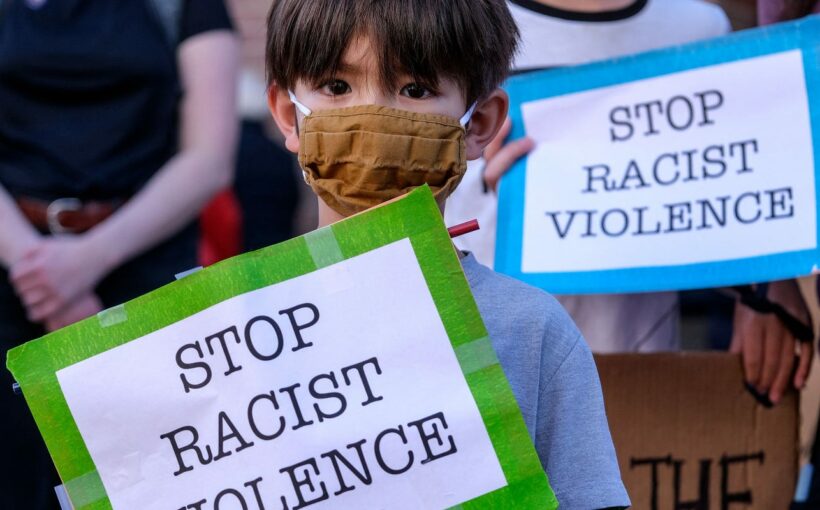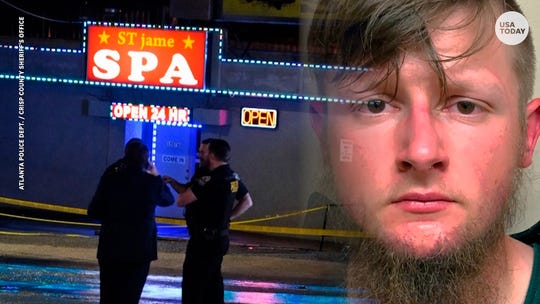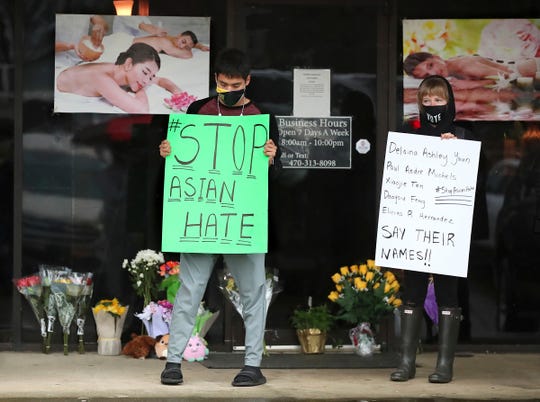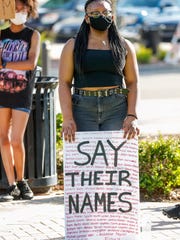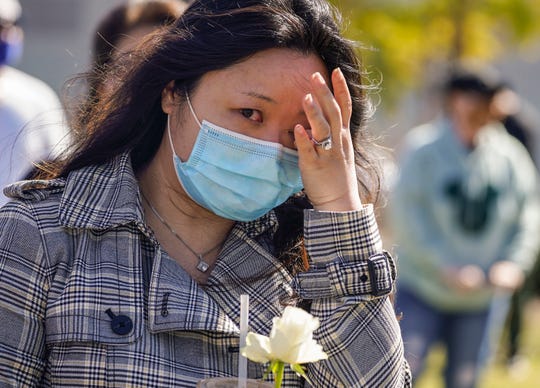When Frank Wu heard the news about this week’s mass shooting in Atlanta, he immediately wondered whether the racial aspects of the tragedy, whose victims were mostly Asian women, would be taken seriously.
“Who looks at that and says it’s random?” said Wu, president of Queens College, City University of New York. “How many Asian people have to be killed before you see a pattern? In Atlanta, if six of eight victims are Asian – I mean, you have to drive around to specific places to find them.”
Eight people, six of them women of Asian descent, were killed Tuesday in three shootings at Atlanta-area spas before police arrested 21-year-old Robert Aaron Long,a white man,and charged him with eight counts of murder and one count of aggravated assault.
For many, the killings were clear acts of racism – and yet the notion seemed to draw pushback from authorities and critics on social media. We’re waiting for the evidence, they heard those institutions say. But the evidence, they thought, is in our experience. Experience reflecting centuries of white supremacy.
Cherokee County Sheriff Frank Reynolds said Wednesday that the suspect, 21-year-old Robert Aaron Long, of Woodstock, Ga., told authorities that his actions were not racially motivated and that he had a sexual addiction. (Photo: Atlanta Police Department/Crisp County Sheriff's Office)
The situation seemed to echo a history of moments when others’ perceived racist experiences – a police shooting of a Black person, policies that put Latino migrant children in cages, a supervisor at work uttering a microaggression, a president smearing people from African nations, and Meghan Markle’s recent accounts of being attacked during her time as a British royal – were downplayed and dismissed by detractors who call such concerns overblown or too emotional.
Despite what they saw with their hearts and minds, those who perceived the Atlanta killings as the crescendo of a year-long wave of anti-Asian violence sensed the event would instead be defined by the same white-dominated institutions that always called the shots.
Jesus Estrella, left, and Shelby stand in support of the Asian and Hispanic community outside Young's Asian Massage on Wednesday in Acworth, Ga. (Photo: Curtis Compton, AP)
“Those in power, and in this case those who are white and male, maintain their power partly by determining and defining what constitutes violations of these rules,” said Charissa Cheah, a psychology professor at the University of Maryland-Baltimore County whose research focuses on families from marginalized backgrounds. “What we are seeing is a key characteristic of institutional and systemic racism and misogyny.”
The victims in the Georgia shootings included a small-business owner, an Army veteran and a wife on a date with her husband. Some of the victims’ names had not been released as of Thursday afternoon; others were identified as Xiaojie Tan, 49, Delaina Ashley Yaun, 33, Paul Andre Michels, 54, and Daoyou Feng, 44. Elcias Hernandez-Ortiz, 30, was injured but survived.
On social media, many people of color, including prominent activists, journalists, writers, athletes, entertainers, former President Barack Obama and others urged the nation to consider the role racism and America’s history of anti-immigrant, anti-Asian and anti-women violence played in the shootings in Georgia regardless of the shooter’s stated motive.
“Many of us can see through this racist mess that the police are trying to say isn’t racially motivated,” wrote religion and Africana studies professor Anthea Butler of the University of Pennsylvania in a thread posted Wednesday morning on Twitter. “Let’s be clear. This is terrorism. It’s murder. It’s AAPI hatred and vilification. It is racist.” (AAPI refers to Asian Americans and Pacific Islanders.)
Jennifer Ho, an ethnic studies professor at the University of Colorado, Boulder, said that while legalities often prevent authorities from labeling incidents as hate crimes early on, “what seems indisputable is that even if you take race aside, he targeted women, and that alone should merit a hate crime. This is a crime of gender.”
Racism often defined by those who have not experienced racism, experts say
Long, of Woodstock, Georgia, told authorities his actions were not racially motivated, attributing them instead to sexual addiction. On Wednesday, Atlanta Police Chief Rodney Bryant said it was too soon to label the tragedy a hate crime.
“We are just not there as of yet,” he said at a news conference.
A boy joins a rally to raise awareness of anti-Asian violence at the Japanese American National Museum in Little Tokyo in Los Angeles. (Photo: RINGO CHIU, AFP via Getty Images)
But the fact that the shootings came in the wake of a year of rising anti-Asian violence and the inflammatory rhetoric of former President Donald Trump’s administration, which often referred to COVID-19 with loaded terms such as the “China virus” and “Kung Flu,” could not be neglected, according to many Americans of color.
“Yesterday’s tragedy must be investigated for what it appears to be,” said legal and policy director Murtaza Khwaja in a statement issued by the Georgia chapter of the Council on American-Islamic Relations. “A hate crime.”
Instead, what Americans saw was Sheriff’s Capt. Jay Baker of Cherokee County, where one of the three spa shootings had taken place, appearing to defend the shooter by saying he’d “had a bad day.”
That response, some said, illustrated the structural challenges faced by victimized populations caught in a system in which the rules have traditionally not favored them.
Those systems exist “because harm is often defined by people who have never experienced the actual harm,” said Gregg Orton, executive director of the National Council of Asian Pacific Americans. “Or they have a vested interest in maintaining their power.”
At October’s vice presidential debate, for example, then-Vice President Mike Pence denied systemic racism as an issue in the wake of widespread social unrest spurred by multiple high-profile deaths of Black Americans at the hands of police, as well as a pandemic and economic upheaval disproportionately affecting people of color.
That same month, Louisville Police Sgt. Jonathan Mattingly, among the officers who fired weapons in a failed drug raid that took the life of Breonna Taylor, a 26-year-old Black medical worker in Kentucky, said the incident was “not a race thing like people try to make it to be.”
And earlier this month in the United Kingdom, “Good Morning Britain” host Piers Morgan slammed Markle’s “incendiary” charges of racism in her interview with Oprah Winfrey, including a claim that a member of the royal family prodded Prince Harry about the color of their unborn child. Morgan, who suggested that “curiosity” rather than racism was behind the inquiry, was forced to step away from the show in the blowback that followed.
A protester holds a sign at a Black Lives Matter protest at Railroad Park in Haines City, Fla., June 12, 2020.
Downplaying the responsibility of those who are racist perpetuates that system, critics said. With the Georgia shootings, it also minimalizes the tragedy’s victims.
Arturo Aldama, chair and associate professor of Latino and ethnic studies at the University of Colorado, Boulder, said victims in such cases often suffer two types of violence as a result: that of the act itself and their subsequent portrayal by law enforcement and the media.
In cases of police brutality and highly publicized shootings of unarmed people of color, for example, officers often claim a sense that their lives were in danger, while media portrayals criminalize the subject.
“Unfortunately for Asian Americans, who have been part of the American fabric since the 1850s gold rush in California, there have been 171 years of ‘bad days,’” Aldama said.
Nearly 3,800 anti-Asian incidents reported in past year
The Atlanta-area shootings recalled large-scale assaults on Asian Americans in the past, including the 1989 shooting of 32 Cambodian and Vietnamese children, five of them fatally, on a playground in Stockton, California, and 19th-century incidents in which dozens of Chinese were slaughtered in separate attacks, including the burning of a Chinatown neighborhood in Los Angeles.
Despite a significant presence in the United States dating to the 1800s, Asian Americans still feel bound by two stereotypes – that of the high-achieving “model minority” and the perpetual foreigner. Both serve to minimize claims of racism by the community, experts said.
“The cultural view of Asians as foreigners and all of us being the same wasn’t created by the pandemic,” said law professor Gabriel Chin of the University of California, Davis. “It was released by the pandemic.”
In a report released this week before the Atlanta killings, Stop AAPI Hate said it recorded nearly 3,800 anti-Asian incidents – including harassment, discrimination and acts of violence – between mid-March 2020 and late February 2021. Women were more than twice as likely as men to report such incidents, the report said.
Sarah Vinson, a forensic psychiatrist based in Atlanta, said the culture of fear created by the rising violence among Asian American communities made it only natural for people to see Tuesday’s shootings in that light.
Esther Song joins a community rally to raise awareness about anti-Asian violence at Los Angeles Historic Park near the Chinatown district in Los Angeles on Feb. 20. (Photo: Damian Dovarganes, AP)
“We have seen a rise in white supremacist acts and in violence against Asian people, so for people to see a shooting that has disproportionately impacted Asian victims and see a tie is the logical thing to do,” Vinson said. “The idea that this has been allowed to go on and that there’s not an outcry about how wrong it is – it does set the stage for someone to up the ante. There’s a way that society can be complicit when it doesn’t address these issues when they are smaller.”
That many had failed to seriously acknowledge the effect of anti-Asian violence until recently “goes back to our society’s messages and narratives about who is good, who is honorable and who are the desired groups of people to be in,” she said.
While it’s important not to jump to conclusions, Vinson said, it’s also important to realize that white people are afforded certain privileges that others are not.
“If this had been an Islamic man with white victims, how would this be talked about?” she said. “There’s a reason for that. It’s the inequity in how these things are promoted.”
And while people of color are hampered by negative bias, the positive bias that benefits white people can also be damaging – as the U.S. Capitol riots of Jan. 6 showed, Vinson said. The attack saw crowds made up largely of white conservatives storm the building, some of them threatening to kill lawmakers.
Rioters attack the Capitol on Jan. 6 in Washington. (Photo: Julio Cortez/AP)
“What happened at the Capitol – there were indicators in place that it was going to happen,” she said. “But people were so wedded to the idea that white people aren’t dangerous that they didn’t see it even when it was right there. So even positive bias can have negative implications for society because the risk of white violence is not properly accounted for.”
Such biases are kept in place by an existing power structure that thrives on Americans’ short memories and tendency not to look at the big picture, said the Rev. Laura Cheifetz, assistant dean of admissions at Vanderbilt Divinity School in Nashville, Tennessee.
“We tend not to see systems or patterns but individual actions,” said Cheifetz, who is of Japanese and white Jewish descent. “So every time there’s a school shooting, rather than thinking ‘What are the larger systems and patterns that led to this violence?’ we think, ‘Oh, that kid – he was bullied.’
“It can feel malicious that others are unable to make what feel like really obvious connections. But that’s how we’ve been able to stand years of deaths through police brutality. It’s scary to admit that’s who we are and acknowledge how much work remains to be done.”
Source: Read Full Article
